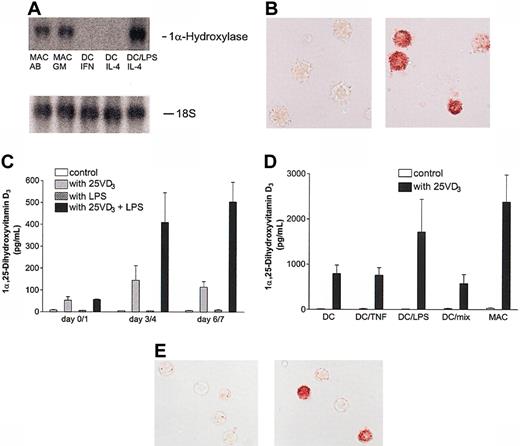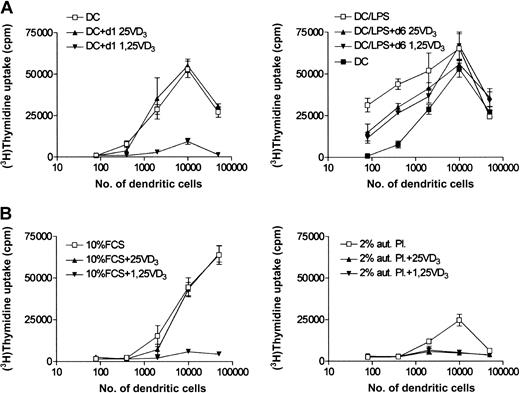Abstract
25-Hydroxyvitamin D3-1α-hydroxylase (25(OH)D3-1α-hydroxylase), the key enzyme of 1α,25-dihydroxyvitamin D3 (1,25(OH)2D3) production, is expressed in monocyte-derived macrophages (MACs). Here we show for the first time constitutive expression of 25(OH)D3-1α-hydroxylase in monocyte-derived dendritic cells (DCs), which was increased after stimulation with lipopolysaccharide (LPS). Accordingly, DCs showed low constitutive production of 1,25(OH)2D3, but activation by LPS increased 1,25(OH)2D3 synthesis. In addition, 25(OH)D3-1α-hydroxylase expression was found in blood DCs but not in CD34+-derived DCs. Next we analyzed the functional consequences of these results. Addition of 1,25(OH)2D3 at concentrations comparable with those produced by DCs inhibited the allostimulatory potential of DCs during the early phase of DC differentiation. However, terminal differentiation decreased the responsiveness of DCs to 1,25(OH)2D3. In conclusion, DCs are able to produce 1,25(OH)2D3 especially following stimulation with LPS. Terminal maturation renders DCs unresponsive to the effects of 1,25(OH)2D3, but those cells are able to suppress the differentiation of their own precursor cells in a paracrine way through the production of 1,25(OH)2D3.
Introduction
The active form of vitamin D, 1α,25-dihydroxyvitamin D3 (1,25(OH)2D3), positively modulates the differentiation of monocyte-derived macrophages (MACs),1,2 whereas the functions of lymphocytes and dendritic cells (DCs) are suppressed.3,4 At least in vitro, monocytes are precursor cells of both MACs and DCs, and the specific microenvironment determines their fate (eg, differentiation into either DCs or MACs). Positive regulators of MAC differentiation such as macrophage colony-stimulating factor or 1,25(OH)2D3 inhibit DC differentiation in vitro.5-9 Accordingly, vitamin D receptor–deficient mice that show an unresponsiveness to 1,25(OH)2D3 have increased numbers of DCs in lymph nodes, suggesting a physiologically relevant inhibition of DC differentiation by 1,25(OH2)D3.10
The normal serum level of 1,25(OH)2D3 is relatively low (10–10 M), whereas that of 25-hydroxyvitamin D3 (25(OH)D3), the major circulating vitamin D metabolite, is about 1000-fold higher. Synthesis of 1,25(OH)2D3 from its precursor 25(OH)D3 normally occurs in the kidney, however several reports describe extrarenal production of 1,25(OH)2D3.11,12 This production is believed not to exert systemic effects but rather suggests a local paracrine function of 1,25(OH)2D3. We and others have shown that MACs convert 25(OH)D3 into 1,25(OH)2D313,14 and have speculated that extrarenal 1,25(OH)2D3 production is involved in the autocrine/paracrine regulation of MAC differentiation. In light of recent publications on the inhibitory effect of 1,25(OH)2D3 on DC differentiation, the absence or presence of 1,25(OH)2D3 within the microenvironment could determine whether a monocyte becomes a MAC or DC. Therefore we were interested as to whether, similar to MACs, DCs can also convert 25(OH)D3 into 1,25(OH)2D3 and found that DCs are indeed a possible extrarenal source of 1,25(OH)2D3.
Study design
Cell separation and culture
DCs and MACs were derived from human blood monocytes or CD34+ as described previously.15,16 Terminal maturation was induced with 10 ng/mL tumor necrosis factor (TNF) or 10 ng/mL lipopolysaccharide (LPS) or a mixture containing 10 ng/mL TNF-α, 10 ng/mL interleukin-1β (IL-1β), 1000 U/mL IL-6, and 1 μg/mL prostaglandin E2.17
Northern blot analysis
A cDNA fragment of 25-hydroxyvitamin D3-1α-hydroxylase (25(OH)D3-1α-hydroxylase) complementary to the nucleic acids +931 base pair (bp) to +2073 bp (GenBank/European Molecular Biology Laboratory [EMBL] accession no. AB005989) was used for hybridization. As a loading control, membranes were rehybridized with an 18S rRNA-oligonucleotide (5′-ACG GTA TCT GAT CGT CTT CGA ACC-3′).
Immunohistochemistry
DCs were fixed with glutaraldehyde and a standard alkaline phosphatase antialkaline phosphatase (APAAP) staining was performed with a polyclonal sheep antibody against mouse and human 25(OH)D3-1α-hydroxylase (The Binding Site, Birmingham, United Kingdom), a secondary rabbit antisheep antibody (Abcam, Cambridge, United Kingdom), APAAP reagent (Dianova, Hamburg, Germany), and Fast Red as a detection substrate (BioGenex, San Ramon, CA).
1α,25-Dihydroxyvitamin D3 ELISA
Cells were seeded (106 cells/well/mL) in RPMI medium in a 6-well plate. After incubation for 24 hours with 5 × 10–8 M 25(OH)D3 (Sigma, Deisenhofen, Germany) with or without 100 ng/mL LPS (Salmonella abortus equi, kindly provided by Dr Chris Galanos, MPI, Freiburg, Germany), the supernatant and the cells were harvested. 1,25(OH)2D3 was separated from other vitamin D metabolites by extraction columns (Immundiagnostik, Bensheim, Germany) and determined with a commercially available enzyme-linked immunosorbent assay (ELISA; Immundiagnostik). This ELISA is specific for 1,25(OH)2D3 and does not recognize other vitamin D metabolites.
Mixed lymphocyte reaction (MLR)
T cells (105) were incubated with different amounts of immature and mature allogenic DCs in RPMI containing 5% T-cell autologous plasma. On day 6 of coculture, 1 μCi (0.037 MBq) of 3H-methyl-thymidine/well was added, and incorporated radioactivity was determined after 20 hours. All samples were performed in triplicates and values represent mean ± SEM.
Results and discussion
25(OH)D3-1α-hydroxylase, the mitochondrial cytochrome P450 enzyme that catalyzes the conversion of 25(OH)D3, was detectable only in the late stages of DC differentiation, and the level of expression was low independent of the culture condition (granulocyte-macrophage colony-stimulating factor [GM-CSF] plus IL-4 vs interferon α [IFNα]).16 Terminal differentiation of DCs with LPS clearly up-regulated the expression (Figure 1A). In contrast, MACs cultured either in human AB-group serum or with fetal calf serum (FCS) plus GM-CSF showed a strong expression of 25(OH)D3-1α-hydroxylase mRNA. CD34+-derived DCs15 cultured with stem cell factor (SCF), GM-CSF, and TNF-α showed no 25(OH)D3-1α-hydroxylase mRNA expression (data not shown). At the protein level, immature DCs on day 7 of culture were weakly positive for 25(OH)D3-1α-hydroxylase (data not shown), and terminal differentiation of DCs markedly increased the expression (Figure 1B). 25(OH)D3-1α-Hydroxylase expression was also found in freshly isolated blood DCs (Figure 1E). The specificity of the 25(OH)D3-1α-hydroxylase antibody used has previously been demonstrated by Zehnder et al18 who detected extrarenal expression of 25(OH)D3-1α-hydroxylase in different tissues (eg, lymph nodes). Parallel staining with CD68 indicated that 25(OH)D3-1α-hydroxylase is expressed in MACs and/or DCs as both cell types express CD68.18,19
Expression of 25(OH)D3-1α-hydroxylase and production of 1,25(OH)2D3 by different types of immature and mature DCs. (A) RNA of monocyte-derived DCs (GM/IL-4, GM/IFNα) and MACs (AB, GM) cultured for 5 days was used for Northern blot analysis. Terminal differentiation of DCs was induced by LPS (DC/LPS). The expression of 25(OH)D3-1α-hydroxylase protein in DCs matured by stimulation with LPS (DC/LPS) was determined by immunohistochemistry. As negative control, staining without the primary antibody is shown (B, left panel). (C) 1,25(OH)2D3 synthesis was measured by ELISA. Freshly isolated monocytes or monocytes differentiated along the DC pathway for 3 or 6 days were harvested and cultured for another 24 hours under serum-free conditions with 25(OH)D3 in the absence or presence of 100 ng/mL LPS. The values represent mean ± SEM of at least 3 experiments. (D) The maturation of DCs was induced on day 4 of culture for 72 hours with tumor necrosis factor (DC/TNF-α) or LPS (DC/LPS) or a mixture containing TNF-α, IL-1β, IL-6, and prostaglandin E2 (DC/mix). The values represent mean ± SEM of 4 experiments. (E) Blood DCs were isolated from mononuclear cells,15 and the expression of 25(OH)D3-1α-hydroxylase was investigated by immunohistochemistry. Original magnification of panels B and E, × 400. In B and E, left panels show negative control (without primary antibody) and right panels show the positive sample (with primary antibody).
Expression of 25(OH)D3-1α-hydroxylase and production of 1,25(OH)2D3 by different types of immature and mature DCs. (A) RNA of monocyte-derived DCs (GM/IL-4, GM/IFNα) and MACs (AB, GM) cultured for 5 days was used for Northern blot analysis. Terminal differentiation of DCs was induced by LPS (DC/LPS). The expression of 25(OH)D3-1α-hydroxylase protein in DCs matured by stimulation with LPS (DC/LPS) was determined by immunohistochemistry. As negative control, staining without the primary antibody is shown (B, left panel). (C) 1,25(OH)2D3 synthesis was measured by ELISA. Freshly isolated monocytes or monocytes differentiated along the DC pathway for 3 or 6 days were harvested and cultured for another 24 hours under serum-free conditions with 25(OH)D3 in the absence or presence of 100 ng/mL LPS. The values represent mean ± SEM of at least 3 experiments. (D) The maturation of DCs was induced on day 4 of culture for 72 hours with tumor necrosis factor (DC/TNF-α) or LPS (DC/LPS) or a mixture containing TNF-α, IL-1β, IL-6, and prostaglandin E2 (DC/mix). The values represent mean ± SEM of 4 experiments. (E) Blood DCs were isolated from mononuclear cells,15 and the expression of 25(OH)D3-1α-hydroxylase was investigated by immunohistochemistry. Original magnification of panels B and E, × 400. In B and E, left panels show negative control (without primary antibody) and right panels show the positive sample (with primary antibody).
Next we measured the 1,25(OH)2D3 levels in the supernatants of immature and mature DCs. Low constitutive production was found in monocytes and immature DCs up to day 4 of culture, but stimulation with LPS always up-regulated 1,25(OH)2D3 synthesis (Figure 1C). Accordingly, terminal differentiation induced with LPS stimulated 1,25(OH)2D3 synthesis, but other inducers of terminal differentiation had no effect on 1,25(OH)2D3 production (Figure 1D). Therefore the up-regulation of 25(OH)D3-1α-hydroxylase by LPS represents an activation rather than a differentiation event. Accordingly, positive regulation of 25(OH)D3-1α-hydroxylase by LPS has already been shown by Reichel et al in human MACs.20
Mature DCs synthesize 1,25(OH)2D3 at a maximal concentration of 5 × 10–9 M. To analyze the functional consequences of 1,25(OH)2D3 production by DCs we added 5 × 10–9 M 1,25(OH)2D3 or 5 × 10–8 M of the precursor 25(OH)D3 to DCs on day 1 and day 6, respectively, and performed mixed lymphocyte reaction. Even at this low concentration, 1,25(OH)2D3 markedly inhibited antigen-presentation capabilities when added in the early stage of DC differentiation on day 1 (Figure 2A), but the precursor 25(OH)D3 had no effect in DCs cultured with 10% FCS. In contrast, DCs generated with 2% autologous plasma were also suppressed by the precursor (Figure 2B). This is in line with our finding that the production of 1,25(OH)2D3 was extremely high under serum-free conditions or in the presence of autologous plasma but low in the presence of FCS (data not shown), indicating an inhibitory effect of FCS on 25(OH)D3-1α-hydroxylase activity. Terminal differentiation has been reported to render DCs unresponsive to the actions of 1,25(OH)2D3 with regard to the expression of the maturation-associated antigen CD83,6 and only these DCs produce high amounts of 1,25(OH)2D3 comparable with MACs. Accordingly, we found a stable expression of maturation-associated antigens on terminally differentiated DCs (data not shown), but exposure to both vitamin D3 metabolites still slightly influenced their capacity for antigen presentation (Figure 2A).
The effect of 1,25(OH)2D3 and 25(OH)D3 on DC function. On day 1 or day 6 of DC culture, 5 × 10–8 M 25(OH)D3 or 5 × 10–9 M 1,25(OH)2D3 (kindly provided by Hoffmann-La Roche, Basel, Switzerland) was added with (right) or without (left) induction of terminal differentiation (A; n = 3). In panel B (n = 2), we compared DCs generated with either 10% FCS (left) or 2% autologous plasma (aut PL; right). After 8 days, antigen presentation was determined by MLR.
The effect of 1,25(OH)2D3 and 25(OH)D3 on DC function. On day 1 or day 6 of DC culture, 5 × 10–8 M 25(OH)D3 or 5 × 10–9 M 1,25(OH)2D3 (kindly provided by Hoffmann-La Roche, Basel, Switzerland) was added with (right) or without (left) induction of terminal differentiation (A; n = 3). In panel B (n = 2), we compared DCs generated with either 10% FCS (left) or 2% autologous plasma (aut PL; right). After 8 days, antigen presentation was determined by MLR.
In summary, our results clearly show that myeloid DCs are a possible extrarenal source of 1,25(OH)2D3. The high local 25(OH)D3-1α-hydroxylase production of 1,25(OH)2D3 by DCs (and MACs) after LPS stimulation may serve as a paracrine signal during bacterial infection and favor MAC differentiation but suppress DC differentiation and lymphocyte activation.
Prepublished online as Blood First Edition Paper, July 10, 2003; DOI 10.1182/blood-2002-11-3521.
Supported by the Deutsche Forschungsgemeinschaft Kr1418/4-2.
The publication costs of this article were defrayed in part by page charge payment. Therefore, and solely to indicate this fact, this article is hereby marked “advertisement” in accordance with 18 U.S.C. section 1734.
We thank Ute Ackermann, Alexandra Müller, and Alice Peuker for excellent technical assistance.



This feature is available to Subscribers Only
Sign In or Create an Account Close Modal